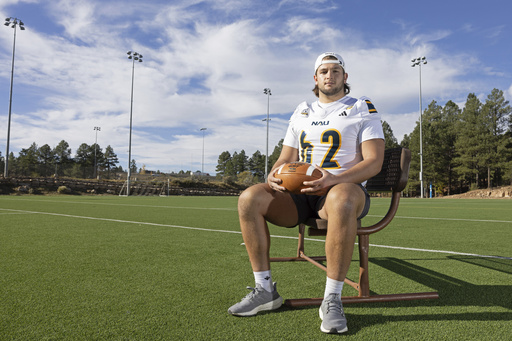
PHOENIX — When Jonny Bottorff decided to transfer to Northern Arizona University on a football scholarship, he was not focused on potential sponsorship opportunities. Over the years, as name, image, and likeness (NIL) deals have proliferated, the offensive lineman has managed to earn a few hundred dollars through these arrangements, yet these earnings have not significantly impacted his life. Bottorff, now 23, earned his bachelor’s degree and is pursuing a master’s at this Division I institution located in Flagstaff, Arizona, after transferring from Missouri Western State University, a smaller Division II school based in Saint Joseph, Missouri.
“Bottorff expressed that for the majority of college athletes, not much has changed. We simply have a little extra money in our pockets, which is a positive shift that was overdue,” he remarked. While NIL deals have revolutionized the experience for some athletes, allowing elite players to earn substantial incomes while still studying, many others acknowledge that obtaining a college diploma remains their primary goal.
Statistics show that student-athletes graduate at rates that often surpass those of non-athletes. Last year, the NCAA reported that a record 91% of athletes in Division I programs successfully graduated. Before the landmark Supreme Court decision in 2021, which determined that U.S.-born athletes could earn income from endorsements and other sources, college athletes adhered to a straightforward understanding with their schools: compete for the chance to earn a degree.
With the advent of NIL deals, athletes such as Washington Commanders quarterback Jayden Daniels and Chicago Sky forward Angel Reese have been able to capitalize on their marketability, securing lucrative sponsorship agreements with prominent brands like Reebok, Powerade, and Beats by Dre while still in school. However, the importance placed on academics varies among students. Several Division I athletes have confirmed that the financial benefits of NIL are a minor aspect in comparison to the value of their education and their passion for sports.
Indiana University basketball player Anthony Leal noted that he is returning for a fifth year to pursue a master’s degree in business administration, despite completing his undergraduate degree last year. “I’m about 70% through the program at the Kelley School of Business,” he stated. “That degree has always been my aim.” NCAA regulations permit athletes up to five years to participate across four seasons, with many utilizing a redshirt year to practice without competing. Additionally, the NCAA granted athletes an extra year of eligibility due to pandemic-related disruptions.
While some view NIL earnings as a motivating factor to remain in college, Leal pointed out that most athletes have a genuine interest in their academic pursuits. “Every student recognizes that education is a crucial aspect,” he said. “Sure, some may have different ambitions, but many understand the significance of school.” The transfer portal has facilitated a more fluid method for athletes at various levels to switch schools, allowing them to compete the following season and explore financially advantageous opportunities, as highlighted in the case of UNLV quarterback Matthew Sluka, who left his team during a dispute over a promised NIL payment.
The NIL market is projected to reach approximately $1.67 billion by the 2024-2025 academic year, with the highest earnings reported among top men’s basketball and football athletes. Despite the NCAA’s recent changes that allow players to transfer seamlessly, the academic transition can still pose challenges. Ray Harrison, who began at Presbyterian College in 2020 and later transferred to Grand Canyon University in 2022, shared that NIL funds were not his motivation; rather, he sought a better environment. “
“God led me here, and winning two conference championships changed the dynamics,” he said. However, the transfer was not without its complications, as many of his credits did not transfer seamlessly. “I had to catch up upon my arrival.”
Similarly, Trinity San Antonio, who transferred from California Baptist University to Grand Canyon, faced difficulties in getting her previously earned credits accepted. “Starting as a freshman when I was technically a junior was less than ideal,” she stated, mentioning her experience as a basketball player in the Paris Olympics last summer as an added achievement.
For many younger athletes, the hope of attaining a college education remains a paramount goal. Tavarius Covington, a high school wide receiver in Chicago, aspires to play in college, with a focus on academics. After a short hiatus from football, he returned last year, motivated by the desire to be the first in his family to attain a college degree. “Watching my little brother play rekindled my interest,” he said. “I want to set a strong foundation for him as a first-generation college student, demonstrating that there is a fulfilling future after high school.”
